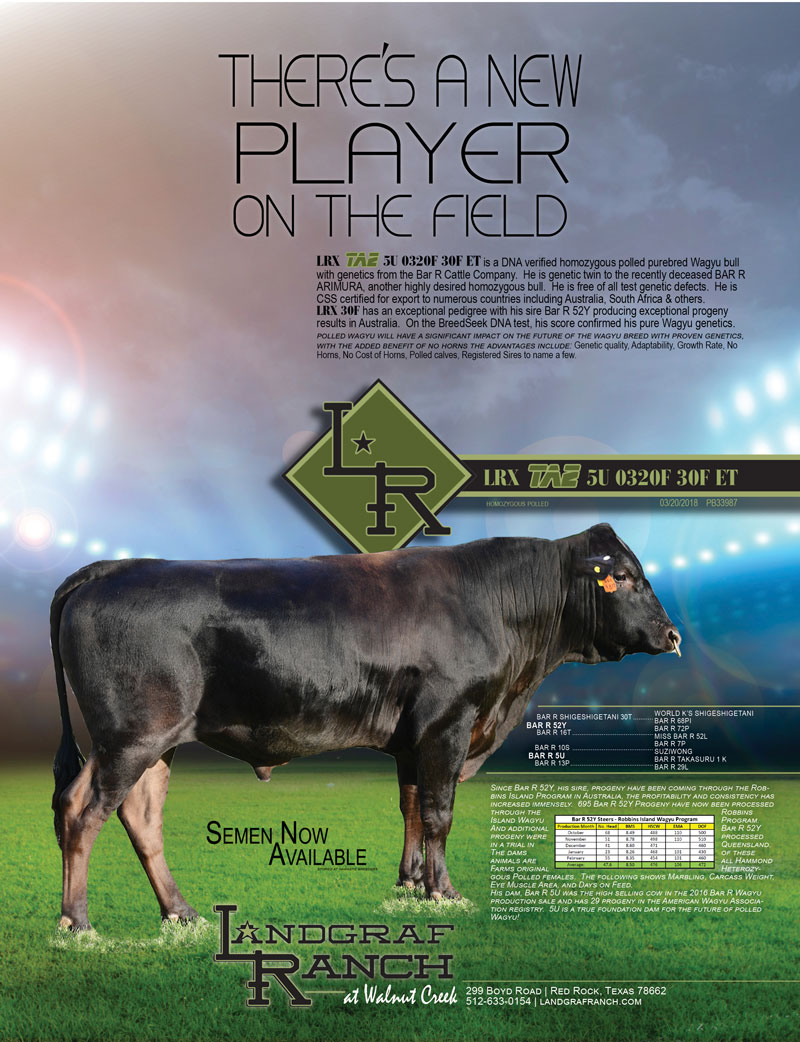Our
POLLED WAGYU
Our Polled Wagyu
LRX 30F Semen Available
Straws available on this outstanding DNA verified Homozygous Polled Wagyu Bull with genetics from the Bar R Cattle Company - LRX 30F. Straws are CSS certified for export to Australia, South Africa and Others. He is genetic twin to the recently deceased BAR R ARIMURA, another highly desired homozygous bull. He is free of all test genetic defects. LRX 30F has exceptional pedigree with his sire BAR R 52Y producing exceptional progeny results in Australia. On the BreedSeek DNA test, his score confirmed his pure Wagyu genetics.
Polled Wagyu will have a significant impact on the future of the Wagyu breed with proven genetics, with the added benefit of no horns, genetic quality, adaptability, growth rate, no cost of horns, polled calves, registered sires to name a few.

Dam
BAR R 5U (PB10038)
Homozygous Polled

Sire
Bar R 52Y (BRCPG0052)
Heterozygous Polled
- View Progeny Carcass Data -
Why Polled Wagyu?
We believe polled Wagyu will have a significant impact on the future of the Wagyu breed. Polled Wagyu are producing Wagyu cattle from proven genetics, with the added benefit of no horns. When we talk about polled genetics, there are basis concepts that should be understood.
Genetic quality – Our purebred polled Wagyu are bred for carcass performance.
Adaptability – Polled bulls acclimate to most climates in the US and Australia. You can introduce poll wagyu genetics to your herd, without impacting your operating system.
Growth Rate – The pre-weaning growth rate among the first drop of poll wagyu calves should be higher of non-polled purebred calves. This is due to the fact that poll calves are not being subject to the stress of dehorning as well as growth genetics. If cattle are dehorned upon arrival to the feedlot, studies have shown the setback in gain can be detected for up to 106 days post dehorning.
No Horns – Welfare concerns related to dehorning – and the associated reputational risks for cattle farmers are mounting. Besides safety issues, dehorning costs time and labor. In intensive grazing systems, the branding or marking process is over 50% faster when dehorning is eliminated.
Cost of Horns – If cattle have horns, it makes every competitive encounter at the feed bunk, hay bale, shade tree, or water trough potentially more dangerous. When horns are left on feedlot cattle, the amount of bruised trim from the carcasses has been reported to be twice that from an equivalent hornless group.
Poll calves – In one breeding season, a producer can take a herd of horned cows and breed them to a polled bull (homozygous for the polled condition) and you are assured 100% poll progeny:
- Over homozygous cows – 100% homozygous poll calves
- Over heterozygous poll cows – 50% homozygous poll calves and 50% heterozygous poll calves
- Over horned cows – 100% heterozygous poll calves.
Registered sires – Our purebred bulls can be registered as sires with the American Wagyu Association (AWA).
About Polled Genetics
Homozygous, Heterozyogous, and Scurred – What does that mean?
The polled / horned gene is viewed as a simple dominant / recessive inheritance. Each parent animal contributes one copy (allele) of the gene to the calf.
The two alleles are: P = Poll and H = Horn.
Every animal carries 2 copies of the gene. Accordingly, there are 3 possibilities: PP, PH, and HH. Polled is dominant to horned. That means that whenever a polled gene is present, the animal does not have horns.
- PP – Polled – this is called Homzygous Polled as the animal carries two dominate polled genes.
- PH – Polled – this is called Heterozygous Polled. Scurs are possible*. The animal may pass a polled gene or horned gene to any progeny.
- HH – Horned – the animal will be horned and will pass a horned gene to any progeny.
*Scurs are small, loose horns or flat bone growth, which are only expressed in heterozygous polled animals. Scurs are controlled by a different set of genes and can occur on polled bulls. Expect a higher incidence in males than females.
Homozygous Poll
Homozygous polled animals will always give you polled progeny regardless of what it is crossed with.
When a homozygous polled animal is crossed with a fullblood Wagyu, which are 100% horned (HH) with a double horned gene, every calf will be polled, or scured. The resulting calf will be heterozygous polled (PH).
When a homozygous polled (PP) animal is crossed with a heterozygous polled (PH) animal, 50% of the progeny will be homozygous polled (PP), and 50% will be heterozygous polled (PH).
Heterozygous Poll
Heterozygous polled animals will give you a combination of polled, scurred, and horned progeny depending on what they are crossed with.
When a heterozygous polled (PH) animal is crossed over a fullblood Wagyu, which is 100% horned (HH), 50% of the progeny will be polled (PH) or scurred. 50% of the progeny will be horned (HH) as well.
When crossed with a heterozygous polled (PH) animal, 25% of the progeny are homozygous polled (PP), 50% are heterozygous polled (PH), and 25% are horned (HH).
If you are ready to acquire polled genetics, please contact us today.


